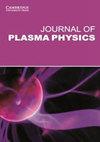小波动等离子体的可用能量
IF 2.5
3区 物理与天体物理
Q2 PHYSICS, FLUIDS & PLASMAS
引用次数: 0
摘要
等离子体的可用能量被定义为等离子体能量在相空间中通过体积保持重排(即所谓的加德纳重堆)而降低的最大值。推导出了近乎均质等离子体可用能量的一般表达式,并证明它与亥姆霍兹自由能密切相关,且永远不会超过亥姆霍兹自由能。文中给出了一些明确的例子。本文章由计算机程序翻译,如有差异,请以英文原文为准。
Available energy of plasmas with small fluctuations
The available energy of a plasma is defined as the maximum amount by which the plasma energy can be lowered by volume-preserving rearrangements in phase space, so-called Gardner restacking. A general expression is derived for the available energy of a nearly homogeneous plasma and is shown to be closely related to the Helmholtz free energy, which it can never exceed. A number of explicit examples are given.
求助全文
通过发布文献求助,成功后即可免费获取论文全文。
去求助
来源期刊

Journal of Plasma Physics
物理-物理:流体与等离子体
CiteScore
3.50
自引率
16.00%
发文量
106
审稿时长
6-12 weeks
期刊介绍:
JPP aspires to be the intellectual home of those who think of plasma physics as a fundamental discipline. The journal focuses on publishing research on laboratory plasmas (including magnetically confined and inertial fusion plasmas), space physics and plasma astrophysics that takes advantage of the rapid ongoing progress in instrumentation and computing to advance fundamental understanding of multiscale plasma physics. The Journal welcomes submissions of analytical, numerical, observational and experimental work: both original research and tutorial- or review-style papers, as well as proposals for its Lecture Notes series.
 求助内容:
求助内容: 应助结果提醒方式:
应助结果提醒方式:


